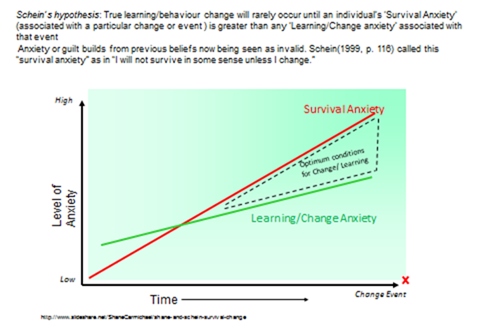
“If you have been trained to think in a certain way and are a member of a group that thinks the same way, how can you imagine changing to a new way of thinking?”
– Edgar Schein
Your organization and work are changing around you, whether you want it to or not.
Understanding how this change takes place, the steps people go through, and the systems-that-drive the negative and positive behaviors are requisite to this change lasting or fading away.
Change and Complexity are conjoined like twins with a secret language.
The greater your business and you can understand, handle and plan for complexity, the more likely the change will happen.
3 Stages of Change
- Lewin/Schein change Model – Summation from ‘The Corporate Culture Survival Guide’ Edgar Schein

Stage 1 – becoming motivated to change (unfreezing)
Multiple forces established by past observational learning + experience, and cultural influences tend to maintain the current behavior.
Change requires adding new forces of change or removing some of the existing factors at play in perpetuating the behavior.
Observed Behaviors and Actions Common in Stage 1
- Denial
- Scapegoating, passing the buck, dodging
- Maneuvering & Bargaining

Stage 2 – change what needs to be changed (unfrozen and moving to a new state)
Once sufficient dissatisfaction with the current conditions and a real desire to make some change exists, it is necessary to identify exactly what needs to be changed, if not already articulated in the first stage.
Observed Behaviors and Actions Common in Stage 2
- Words take on new and expanded meaning
- A concept is interpreted within a broader context
- There is an adjustment in the scale used in evaluating new input relative to what had previously been learned and accepted as factual.

Stage 3 – making the change permanent (refreezing)
Refreezing is the final stage, where the action becomes habitual. This requires behavior consistent with other behaviors and the values and beliefs held by the individual.
Observed Behaviors and Actions Common in Stage 3
- Develop a new self-concept and identity
- Establishing the new behavior in interpersonal relationships.
How do you get past the resistance to change?
Two principles have to be considered:
- 1 – Survival Anxiety must be greater than Learning Anxiety.
- 2 – Learning Anxiety must be reduced rather than increasing Survival Anxiety.
Survival Anxiety & Learning Anxiety – “Once the evidence of a need for change happens, you will feel Survival Anxiety or Guilt. You may not feel the anxiety or guilt directly, but you experience discomfort that something bad may happen to you if you don’t respond in some way. You begin to recognize the need for change; you also realize that a new behavior may be required and difficult to learn, and the new beliefs or values implied may be difficult to accept. This discomfort is best thought of as Learning Anxiety.” – Schein pp. 111
Working Through Change + Learning Anxiety

What do you think?
How might you incorporate the Lewin/Schein 3 stages of change and the ideas of Survival plus Learning anxiety into your work?

